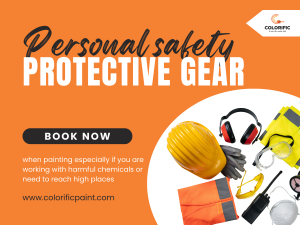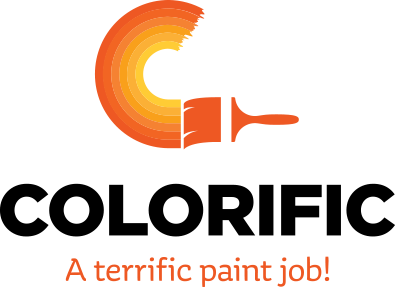Painting your house can be exciting but safety should always come first. Whether you are painting yourself or hiring professionals it is important to take some precautions to keep everything safe.
From avoiding toxic fumes to staying careful while working at heights this guide will walk you through steps to prepare for painting while reducing health risks and accidents.
1. Ventilation and Air Quality Management
One of the most important safety concerns when painting indoors is air quality. Paints especially oil-based ones release harmful gases that can affect your health. Breathing in these fumes may lead to headaches dizziness or breathing problems.
Make sure air flows properly
Before starting any painting project indoors open windows and doors to let fresh air come in. Proper airflow helps clear out harmful fumes. If the room doesn’t have good ventilation use fans to help move the air.
Use exhaust fans
If you are painting places like bathrooms or kitchens turn on exhaust fans to push fumes outside. Put box fans in windows so they blow out the fumes while pulling in fresh air from other openings.
Pick paints with fewer harmful chemicals
Choose paints that are low or have no harmful gases. These paints are better for the environment and safer for everyone in the house especially kids pets or people with breathing problems.
Wear masks or respirators
A mask made for painting will help protect you by filtering harmful fumes and particles. This is especially important when working in closed spaces or with oil-based paints.

2. Surface Preparation and Lead Paint Safety
The condition of your home’s walls or other surfaces plays a key role in both safety and the quality of your paint job. Prepping your surfaces the right way also reduces health risks.
Check for lead paint
If your house was built before 1978 there might still be old layers of lead-based paint. Lead is very dangerous and can cause serious health problems especially in children. Before you start painting have a professional check for lead. If there is lead don’t try to remove it yourself hire a certified expert to handle it safely.
Clean the surfaces
Dirt grime or mold should be cleaned off walls before painting. Dust and particles can become airborne when you sand or scrape the walls which can harm your lungs. Use a damp cloth or sponge to wipe surfaces or a special cleaner if needed.
Wear protective gear
While preparing surfaces wear gloves goggles and a mask to protect yourself from dust or cleaning chemicals. Sanding produces fine particles that are harmful to breathe in.
3. Protective Gear (PPE)
Personal safety gear is necessary when painting especially if you are working with harmful chemicals or need to reach high places. Proper gear helps protect you from chemical exposure and prevents accidents.
Wear protective clothing
Use old clothes or disposable coveralls while painting since paint can be tough to remove and can also irritate your skin. Long sleeves and pants keep your skin safe from splashes or spills.
Wear gloves
Use gloves that resist chemicals like latex or nitrile to protect your hands from paint and cleaning solutions. This is especially important when working with oil-based paints or paint thinners.
Use goggles or safety glasses
Goggles will protect your eyes from splashes of paint or dust from sanding. Eye protection is necessary when painting ceilings or working at higher levels.
Wear a mask or respirator
Masks help keep harmful fumes or dust out of your lungs. Use a respirator designed for painting if you are using oil-based paints or working in a space without much airflow.
Use slip-resistant shoes
Make sure to wear sturdy shoes that won’t slip if you are climbing ladders or moving around.
4. Ladder and Scaffolding Safety
When painting high places you might need to use a ladder or scaffolding. Falls are one of the most common causes of accidents during painting so it is very important to stay safe when working at heights.
Check your equipment
Before using a ladder or scaffolding look for any signs of damage like cracks or missing pieces. Make sure everything is stable and that the ladder’s locking mechanisms work.
Choose the right ladder
Make sure your ladder is tall enough for the job. Don’t use the top step of the ladder since it can make you unstable. If you need to paint high ceilings or outdoor walls you might want to use scaffolding for better balance.
Position the ladder carefully
Always place the ladder on a flat solid surface. If you are working outside make sure the ground is even. Keep the ladder angled correctly — about one foot away from the wall for every four feet of ladder height.
Use the three-point contact rule
When climbing or getting off a ladder always keep two hands and one foot or two feet and one hand on the ladder. This helps you stay steady and reduces the chance of falling.
Don’t overreach
If you need to reach a far area move the ladder instead of stretching out. Overreaching is a common cause of falls.
5. Handling and Storing Paints Safely
Paints thinners and cleaners can be flammable or toxic if not used properly. Handling and storing these materials safely will help avoid accidents like fires or chemical exposure.
Read labels carefully
Look at the labels on paint cans and cleaners to understand any risks. Follow instructions for safe handling storage and disposal.
Store paints safely
Keep paint and cleaning products in a dry place that has good airflow and is away from heat. Make sure lids are tight to avoid spills and limit the amount of fumes.
Dispose of leftovers the right way
Don’t pour leftover paint down drains or throw it in the trash. Many places have rules about how to safely get rid of paints. Check with your local waste management service for the best way to dispose of old paint.
6. Protecting Furniture and Floors
Painting can get messy so protecting your belongings from drips and spills is important.
Cover furniture
Move as much furniture as you can out of the room. If you can’t move it cover everything with plastic or drop cloths to prevent paint splatters.
Use drop cloths
Put down drop cloths to protect floors especially carpets or wood. Use thick cloths that won’t move easily or tear while you are working. Be careful not to trip over them while you move around.
Tape off edges and fixtures
Use painter’s tape to cover baseboards light switches or other things you don’t want painted. This will make it easier to keep paint only where you want it.
7. Keeping Children and Pets Safe
If you have kids or pets it’s important to keep them safe during the painting project.
Keep them out of the area
Make sure to block off rooms where you are painting so children or pets don’t come in. Paint fumes are especially harmful to small children and animals so it is best to keep them away until the paint is dry and the fumes are gone.
Put away painting materials
Paint cans brushes and other materials should be kept out of reach from children and pets to prevent accidents.
8. After Painting Clean-Up and Safety Checks
Once the painting is done cleaning up properly is just as important for safety.
Get rid of supplies safely
Dispose of used rags brushes and leftover paint in the right way. Don’t leave paint-covered rags in piles since they can catch fire.
Let the paint fully dry
Make sure the paint is fully dry and the fumes have cleared before going back into the room. Keep windows open for at least two days after painting to help with airflow.
Check the area for any leftover hazards
After painting make sure all tools and materials are cleaned up and put away. Take down ladders and scaffolding so no one accidentally gets hurt.
Final Thoughts
Getting your house painted is all fun until something happens that can risk your health.
Safety should always be your first priority, no matter if your house is getting painted or re constructed. By following the safety guidelines provided, including good ventilation and protective gear, you can have your space all good and beautiful without any harm to your health.
Colorific Paint knows very well how to maintain a safe environment before painting any house. Book a consultation with them now and get all your queries clear about it!
Read More: Choosing the Best Exterior Paints for Houses in Harsh Climates
Read More: Must-Have Paint Prep Tools for Perfect Wall and Concrete Finishes
Read More: How to Prepare Walls for Painting: A Step-by-Step Guide
Read More: Mildew Resistance – The Best Exterior Paints for Damp Climates
Read More: Selecting Best Commercial Painting Contractor
Read More: Comprehensive Commercial Painting Services: Interior and Exterior Solutions
Read More: Comprehensive Guide to Wall Repair Methods and Wood Restoration: Techniques and Products
Read More: How to Make the Most of Your Exterior Paints Purchase
Read More: The Ultimate Guide to Interior Paint Types
Read More: Trending Interior Paints Colors and Combinations
Read More: Commercial Painting Supplies: Essential Tools You Need for Successful Projects
Read More: Residential Painting Services: A Homeowner’s Guide to Professional Results,

